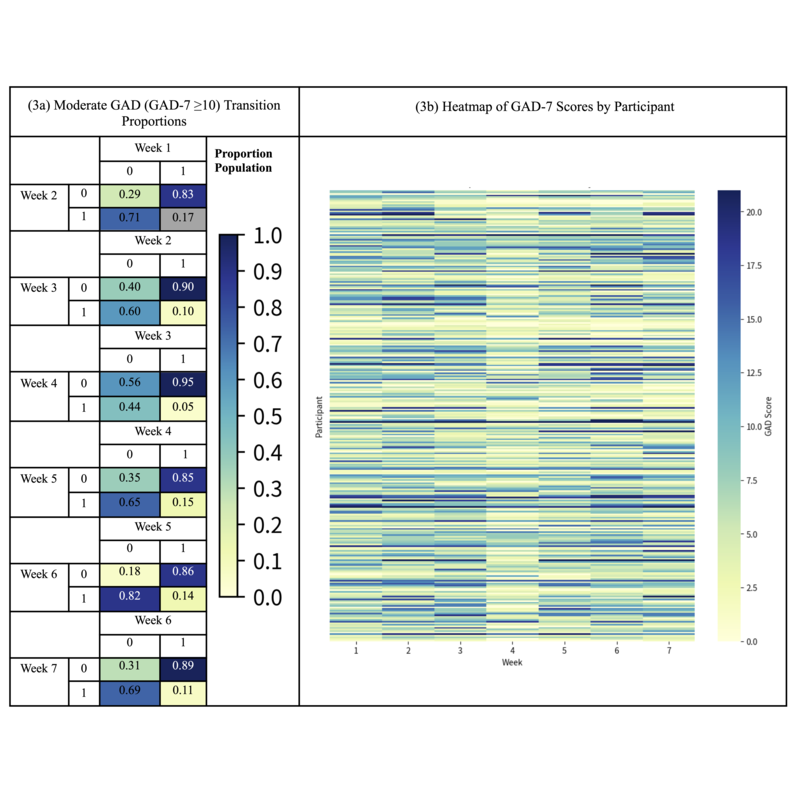Events and behaviors associated with symptoms of generalized anxiety disorder in first-year college students
L. S. P. Bloomfield, M. Fudolig, P. S. Dodds, J. Kim, J. Llorin, J. Lovato, E. McGinnis, R. McGinnis, M. Price, T. Ricketts, K. Stanton, C. M. Danforth

Times cited: 0
Abstract:
Objective: Identifying associations between individual characteristics, psychological history, academic stressors, and the trajectory of generalized anxiety disorder symptoms in a college cohort may provide insight into the design of mental health interventions.
Method We recruited first-year undergraduate students between the ages of 18-24 at a university in the northeastern United States. Following consent, enrolled participants completed surveys between October 21, 2022 - December 12, 2022 on self-reported exposures to potentially traumatic life events, mental health history, and stressors. The main outcomes of interest were the occurrence, persistence, development, and reduction in generalized anxiety disorder (GAD) symptoms using the Generalized Anxiety Disorder Questionnaire (GAD-7).
Results:
A previous anxiety disorder diagnosis was associated with occurrence (adjusted odds ratio [AOR], 2.10; 95% CI, 1.51-2.93), persistence (incidence rate ratio [IRR], 1.64; 95% CI, 1.29-2.09), and duration of GAD symptoms during the study (IRR, 2.90; 95% CI, 1.30-6.46). Prior exposure to traumatic life events was associated with the occurrence (AOR, 1.80; 95% CI, 1.28-2.52) and persistence of GAD symptoms (IRR, 1.36; 95% CI, 1.06-1.74). The presence of a test or project was associated with occurrence (AOR, 1.68; 95% CI, 1.42-1.98), persistence (IRR, 2.09; 95% CI, 1.43-3.04), and development of GAD symptoms(AOR 1.58, 95% CI, 1.30-1.92), and decreased the likelihood of GAD symptom reduction (AOR, 0.69; 95% CI, 0.56-0.86). The personality trait of emotional stability decreased the likelihood of occurrence (AOR, 0.60; 95% CI, 0.50-0.67), persistence (AOR, 0.90 95% CI, 0.65- 0.78), development (AOR, 0.84; 95% CI, 0.77-0.92), and reduction in GAD symptoms (AOR, 0.82; 95% CI, 0.75-0.88). The personality trait of extraversion also decreased the likelihood of GAD symptoms (AOR, 0.89; 95% CI, 0.83-0.95).
Conclusion:
These findings suggest that beginning college with a history of an anxiety disorder or prior exposure to multiple traumatic events increases the likelihood of occurrence and persistence of a GAD-7 score consistent with moderate-to-severe GAD symptoms. Personality traits also play a role in the occurrence and persistence of GAD symptoms, which may be important for personalizing psychological treatments. Academic stressors (i.e., a test or project), were significantly associated with the presence, persistence, development, and reduction in GAD-7 scores consistent with moderate-to-severe GAD symptoms.
Method We recruited first-year undergraduate students between the ages of 18-24 at a university in the northeastern United States. Following consent, enrolled participants completed surveys between October 21, 2022 - December 12, 2022 on self-reported exposures to potentially traumatic life events, mental health history, and stressors. The main outcomes of interest were the occurrence, persistence, development, and reduction in generalized anxiety disorder (GAD) symptoms using the Generalized Anxiety Disorder Questionnaire (GAD-7).
Results:
A previous anxiety disorder diagnosis was associated with occurrence (adjusted odds ratio [AOR], 2.10; 95% CI, 1.51-2.93), persistence (incidence rate ratio [IRR], 1.64; 95% CI, 1.29-2.09), and duration of GAD symptoms during the study (IRR, 2.90; 95% CI, 1.30-6.46). Prior exposure to traumatic life events was associated with the occurrence (AOR, 1.80; 95% CI, 1.28-2.52) and persistence of GAD symptoms (IRR, 1.36; 95% CI, 1.06-1.74). The presence of a test or project was associated with occurrence (AOR, 1.68; 95% CI, 1.42-1.98), persistence (IRR, 2.09; 95% CI, 1.43-3.04), and development of GAD symptoms(AOR 1.58, 95% CI, 1.30-1.92), and decreased the likelihood of GAD symptom reduction (AOR, 0.69; 95% CI, 0.56-0.86). The personality trait of emotional stability decreased the likelihood of occurrence (AOR, 0.60; 95% CI, 0.50-0.67), persistence (AOR, 0.90 95% CI, 0.65- 0.78), development (AOR, 0.84; 95% CI, 0.77-0.92), and reduction in GAD symptoms (AOR, 0.82; 95% CI, 0.75-0.88). The personality trait of extraversion also decreased the likelihood of GAD symptoms (AOR, 0.89; 95% CI, 0.83-0.95).
Conclusion:
These findings suggest that beginning college with a history of an anxiety disorder or prior exposure to multiple traumatic events increases the likelihood of occurrence and persistence of a GAD-7 score consistent with moderate-to-severe GAD symptoms. Personality traits also play a role in the occurrence and persistence of GAD symptoms, which may be important for personalizing psychological treatments. Academic stressors (i.e., a test or project), were significantly associated with the presence, persistence, development, and reduction in GAD-7 scores consistent with moderate-to-severe GAD symptoms.
- This is the default HTML.
- You can replace it with your own.
- Include your own code without the HTML, Head, or Body tags.